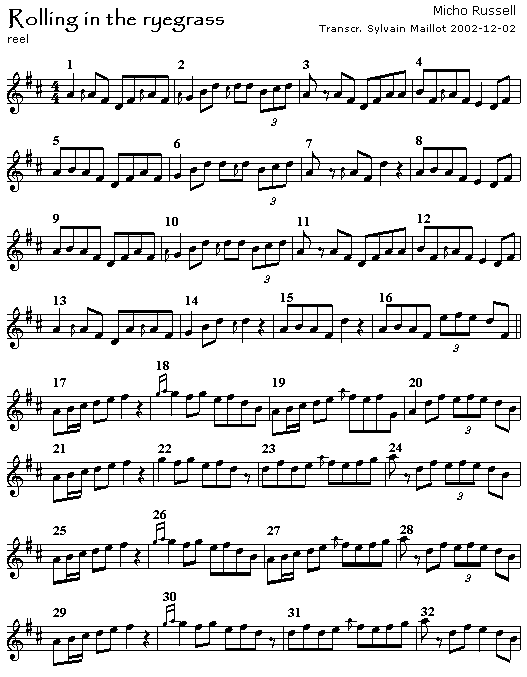Transcribed by Sylvain Maillot, with comments by Steve Jones, 19 December 2002

This recording is of two reels, Rolling in the ryegrass and Miss Monaghan, both played with Micho Russell's characteristic individuality and freshness on a E-flat whistle. Only the first tune is transcribed here. (Another fine interpretation of this tune by Kieran Collins was transcribed earlier - see the index page).
The clip was supplied by Peter Laban, to whom Micho refers in his introductory remarks:
"This is the last tune [...] I'd like a young man by the name of Peter to come up to play... we'll play tunes together. He'll play the pipes and I'll play the flat tin whistle. So, this reel would be for an old friend of mine, a reel called The Shannon breeze or Rolling in the ryegrass."
(Peter played a set of C pipes, so by "flat tin whistle" Micho means a C whistle.)
This is Micho at his best - a sweet, full tone and a lovely bouncy rhythm.
In bars 2, 6, 10 and 14, Micho dispenses with the usual "rocking pedal" figure with a G pedal, substituting a very characteristic device consisting of three high d notes in succession. The first and second are separated with a cut, while the second and third are articulated by tonguing.
To my ear this sounds like a case of the whistle imitating the concertina, which was a popular instrument in West Clare in Micho's youth (and still is today). Beginning whistlers may like to experiment with this device as a useful and very effective substitute for a common-or-garden roll, the "tap" or "pat" being replaced with a tongued third note. This can be used on any note, not just Ds.
Note also that the cut between the two high d notes produces a very characteristic Micho sound, obtained, I think, by having the top hole vented and cutting with the bottom finger of the top hand.
Another concertina-ish touch can be heard at the ends of bars 3 and 11, where Micho repeats the note of A rather than playing A, F#.
In bars 16, the normal E quarter note is pushed up an octave, anticipating the corresponding phrase in the B part.
The ascending triplet figures in bars 17, 21, 25 and 29 are a distinctive, as is Micho's consistent pause for breath at the end of these bars (rather than, for example, immediately after the first beat of the following bar).
Steve Jones, 19 December 2002